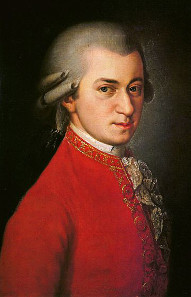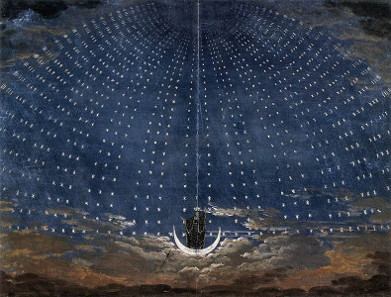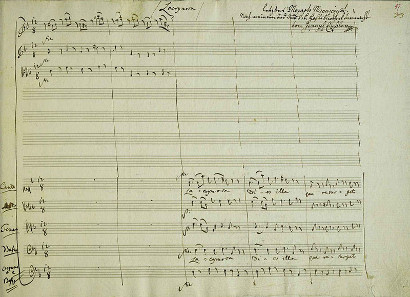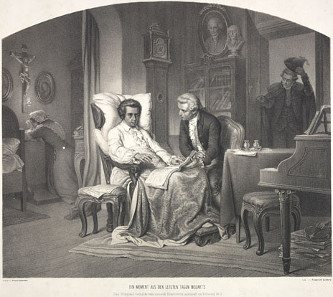By
Translated by Honeycutshome
Mozart is a brand, just like Coca Cola, Mercedes or Apple. With his name, everything can easily be sold: the Getreidegasse (Grain Lane) in Salzburg, the real Mozartkugeln (Mozart ball) and the country of Austria that depicts on his coins a composer who, strictly speaking isn’t of Austrian descent. After all, the Mozart family originated from Augsburg in the first place. His father, however, being a talented musician had taken up a post in the orchestra of the Archbishop of Salzburg. Back then, Salzburg was an independent ecclesiastical principality in the Holy Roman Empire. That was the place where Wolfgang Amadeus Mozart was born on 27 January 1756.
Posthumous portrait of Wolfgang Amadeus Mozart by Barbara Krafft, 1819. Source: Wikicommons.
The well-ordered life of the family drastically changed when father Mozart noticed the extraordinary musical talents of his son. Leopold intended to exploit these talents. You see, the bored princely courts loved the so-called Wunderkind, children who acted like adults, made music, beaten their enemies on the chessboard or solved such difficult math problems that the onlookers were awestruck just by reading. Wolfgang Amadeus Mozart was not the only Wunderkind but he was more gifted than many others. And so his father decided to make his family’s fortune by a concert tour throughout Europe with his son and his daughter.
The Mozarts on concert tour: Leopold, Wolfgang and Nannerl. Watercolor by Louis Carrogis Carmontelle, around 1763. Source: Wikicommons.
That was how the little boy became acquainted with the greats of the then world. Countless anecdotes tell about he moved in the royal circles: he is said to have crawled in Empress Maria Theresia’s lap, and he also allegedly proposed marriage to Mary Antoinette when she picked up the little one after he had fallen on the slippery floor of the palace. The first voyage was followed by a second one. The destination was Paris where the child prodigy performed at the court of Louis XV. In London, he delighted King George III. Afterwards, the Mozarts toured through Germany, Holland, Switzerland, Bohemia, Italy, in short the entire civilized world of that era. Little Wolfgang were the celebrated star everywhere. He was spoilt, used to be at the center of attention at all times, and most likely he never really reflected upon the class distinction that separated him from his hosts. It was his talent that automatically made him part of the higher echelons of society – at least this was how he saw it in all probability.
But Wolfgang Amadeus was soon knocked out of the skies. The child grew into young man but young men weren’t wunderkind material. Hence, Wolfgang needed a permanent job. His father tried to get him a position in the orchestra of the Salzburg Archbishop Count Hieronymus Colloredo – with success. The archbishop, on the other hand, was more than amazed at the young man’s pretensions. After all, Mozart was nothing more than a musicus, in the 18th century a profession just like any chef or tailor. The world collapsed on Wolfgang Amadeus. Such great a difference between the devoted affection of his noble fans and the indifference of his employer! Salzburg became too tight for him. He wanted to travel again, in order to collect loads of donations.
Wolfgang Amadeus Mozart at the age of 21, wearing the Order of the Golden Spur. Source: Wikicommons.
Mozart went on concert tour. He headed for Paris that was renowned for its noble patrons of the arts. What he missed, however, was the fact that he was already 21 years of age at that time. Granted, he was an excellent pianist, a true virtuoso. Unfortunately, there were not enough real music experts amongst the rich and famous who were able to truly appreciate his skills. It is easy for a wunderkind to win hearts, but the adult Mozart came hard to meeting his expenses. Still on his way to Paris, the money poured from his pockets while revenues were small. In addition, he got ripped off: lovely Aloysia Weber turned his head and was given singing lessons for free in turn. Mozart introduced her as THE singer to the salons. He even covered her travel expenses which she thanked him by demanding half of all of his revenues.
Paris in itself was a disaster. Nobody was interested in the 21 year-old. There was nothing else for him but to return to hated Salzburg with 500 gulden annual salary. The adventure had cost the family 863 gulden. Now, Wolfgang Amadeus faced the challenge of copying with the daily life of a musician. He was sent to Vienna but he couldn’t manage with the living conditions there. It came as a shock to him that he had to dine with the menial staff and wasn’t allowed to take on any engagements without authorization. The final straw was the kick a noble man gave the young man (presumably with good reason). Mozart was offended. It wasn’t much of a help that his father tried to calm him down by pointing out that the Mozarts simply were not of noble descent and hence not capable of giving satisfaction – in other words that they didn’t possess any honor in danger to get compromised in the first place.
Mozart quitted the archbishop’s services and started his own business in Vienna. He did quite well with all the concerts, operas, symphonies and arias he wrote. The thing was, he simply didn’t have a way with being economical. Constanze, the woman he had married against his father’s express will, likewise didn’t budget. And so money was earned with one hand and spent with the other.
Mozart couldn’t get himself a permanent position. Maria Theresia had been succeeded by Joseph II who – presumably just like most of his contemporaries – fostered no greater interest in music. He employed a couple of composers and relied on their judgement. Why should the established musicians recommend a young man then who was constantly mocking them? Mozart didn’t make friends amongst the musicians. It was only logical that Mozart’s name seldom sprang to the mind of those people who made commissions.
Stage set for Mozart’s Magic Flute by Karl Friedrich Schinkel, 1815. Source: Wikicommons.
During the years Mozart spent in Vienna he wrote his most famous works. Amonst others, these include ‘Entführung aus dem Serail’ (The Abduction from the Seraglio), ‘Don Giovanni’ and ‘Zauberflöte’ (Magic Flute). And he got paid for these works. Another man would have run a modest but stable household with that money, perhaps making some extra money with piano, singing or composing lessons. That wasn’t Wolfgang Amadeus Mozart’s cup of tea. Giving lessons was beneath Mozart’s dignity. It was his friends that helped him out with money whenever there was a case of emergency. Surely but steadily, Mozart went south. Admittedly, he was still a genius, actually creating his greatest works in the final stage of his life, but the dire living conditions caused him great discomfort. His father Leopold had died, he had sent his wife Constanze to a health resort after recovering from an illness, and so he spent his final days in relative solitude. Mozart sank into depression. That might have been a side effect of a kidney disease that was to cost him his life. And so the commission of a requiem marked the beginning of the end of his life.
Bars 1 to 5 of the Lacrimosa of the unfinished “Requiem” by W. A. Mozart, 1791. Source: Wikicommons.
In 1791, a glowering skinny man in mourning clothes ordered a requiem with Wolfgang Amadeus Mozart. No, that man wasn’t Salieri, that jealous adversary of the beset genius. It was an attendant of Count Walsegg. This count used to commission musical works by any number of composers, only to copy these works and have them performed at his court without giving the composers credit by stating their names. The spouse of the count had just died which was why the servant wore the black mourning livery when he approached Mozart, the intended next victim to the count’s scam. Mozart accepted the order and took the 100, others say 50, ducats albeit without agreeing on fixing a date for delivery.
At first, other duties took priority. Mozart finished the Magical Flute, did one or two commissions, but the gloomy messenger of the count kept coming to him to remind him of the promised requiem. When Mozart’s health was more and more deteriorating, the servant in the black livery became something of a harbinger of death to him. In his imagination, it was death itself that had commissioned the requiem. Mozart composed his own requiem mass. This composition dominated his last days. As late as his death-day he had summoned his friends in order to perform with them the just finished parts of his requiem. He sang alto but only for a couple of notes until he burst into tears. In the late afternoon, he gave his favorite pupil instructions as to how the finale of the requiem was to be executed and conducted an imaginary choir. “The last movement of his lips was an endeavor to indicate where the kettledrums should be used in the Requiem” his sister-in law writes who sat at the deathbed, together with her sister.
“Ein Moment aus den letzten Tagen Mozarts” (Moment from the Last Days of Mozart), lithography by Friedrich Leybold 1857 after descriptions of Franz Schramms. Source: Wikicommons.
Mozart didn’t leave much money. 60 gulden was all his surviving wife and her two children have for starting their new life. So, Constanze was stingy in regard to the funeral. Third class obsequies for 8 gulden and 36 kreutzer were deemed sufficient for the genius that used to perform before the eyes of kings and princes. 3 gulden was the price of the hearse. Candles were few in number on 6 December 1791, when the mass was celebrated in St. Stephen’s Cathedral. A couple of long-standing friends had shown up but only few musicians. Also attending was Salieri, who Mozart, in a fit of madness, accused of having poisoned him. When the small congregation came to the gate of the cemetery, suddenly there was severe weather which prevented anybody to follow the coffin to the burial spot. The gravediggers were the only persons that accompanied Wolfgang Amadeus Mozart on his last way. Nobody laid flowers or had a cross erected. The place where one of the most important musicians of all times is buries remains undetected until the present day.
More about the famous artist in this BBC film “The Genius of Mozart” on YouTube.
The virtuoso also features in the Salzburg issue of Austrian Mint’s “Austria by its Children” series.
If you want to see Austria’s 2 Euro circulation coins, featuring Bertha von Suttner, have a look at this CoinsWeekly article.









